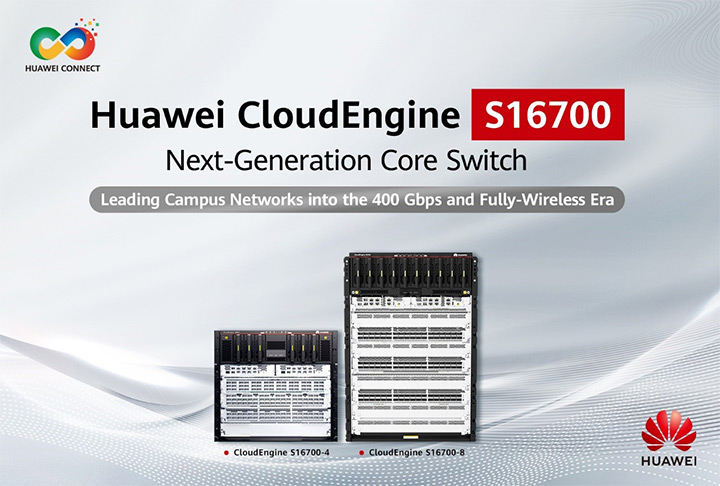Este sitio utiliza cookies. Si continúa navegando en este sitio, acepta nuestro uso de cookies. Lea nuestra política de privacidad>
![]()
Este sitio utiliza cookies. Si continúa navegando en este sitio, acepta nuestro uso de cookies. Lea nuestra política de privacidad>
![]()
Productos, soluciones y servicios empresariales
Digital transformation is sweeping across the world, and cloudification is a growing trend among enterprises looking to deploy digital services. Indeed, Gartner predicts that more than 85% of enterprise services will be deployed on the cloud by 2025. Meanwhile, according to IDC's forecast, there will be 41 billion connected IoT devices and over 14 billion connected non-IoT devices globally by 2025.
Campus networks are the bridge between clouds and numerous devices. And the key to campus networks is core switches, as they transmit massive amounts of data traffic generated from enterprise office, production, and operations processes.
With the growing adoption of new applications and services, an inevitable megatrend is upgrading the bandwidth of core switches from 25GE and 100GE to 400GE.
Against this backdrop, Huawei recently unveiled its all-new CloudEngine S16700 series campus switches, the industry's first campus core switches for the fully-wireless and intelligent era. These purpose-built switches come with ultra-high densities of 10GE, 40GE, 100GE, and 400GE ports, facilitating smooth campus network evolution to 400 Gbit/s. The single-slot bandwidth of CloudEngine S16700 reaches a record high of 14.4 Tbit/s, four times higher than comparable products in the industry. All of this greatly reduces the number of required devices at the core layer, simplifying the entire network and improving management efficiency.
How did Huawei make this happen? This is thanks to the ground-breaking technical improvements and innovations Huawei has made in the Printed Circuit Board (PCB) materials, techniques, heat dissipation, and power supply of CloudEngine S16700.

Huawei CloudEngine S16700
CloudEngine S16700 stands out with three cutting-edge technologies:
• Superfast forwarding: 14.4 Tbit/s bandwidth per slot, four times the industry average
The first obstacle to the evolution from 100 GE to high-density 400 GE is improving the high-speed signal transmission capability. Inside a switch, the interconnection signal frequency of a 400 GE port is higher than 53 GHz. Each time the signal frequency doubles, the signal attenuation of the PCB increases by more than 20%.
Traditional PCBs use common copper foil materials and manufacturing techniques. This results in transmission rate constraints, because the transmission loss and high-frequency interference become more severe as the signal transmission rate increases.
In contrast, Huawei's CloudEngine S16700 adopts new sub-micron lossless PCB materials and unique polymer bonding technology to improve the signal transmission efficiency by 30%. This paves the way for full-lifecycle compatibility and capability evolution from 100 GE to 400 GE.
• All-new architecture: Backplane-free orthogonal architecture increases switching capacity by 50%.
The CloudEngine S16700 uses the industry-leading orthogonal Clos multi-level switching architecture in which service traffic between line cards is directly transmitted to Switch Fabric Units (SFUs) through orthogonal connectors. This design greatly increases the signal transmission rate and improves the switching capacity of the entire system.
A switch system using the orthogonal Clos architecture typically has a large capacity. In terms of physical implementations, "N+1" independent SFU slots are generally used to completely decouple from the control plane of main control boards. The resulting benefits include improved system scalability, greatly enhanced reliability of the forwarding plane, and no impact on the forwarding plane when the control plane is faulty or switchover is being performed.
• Innovative power supply: Dual-input power supply design requires 50% less space and improves efficiency by 90%.
Huawei's CloudEngine S16700 uses the industry's first power module with dual inputs and intelligent switchover, and draws on magnetic blow-out and large exciter technologies to implement fast switchover within milliseconds.
With 49% less space required, 21 of these unique power modules can achieve the same power supply capability and reliability as 40 regular power modules. On top of that, line cards adopt matrix magnetic and high frequency magnetic technologies to provide 1600 watts of power supply capability in a space the size of two thumbs. The end result is 95% higher power supply efficiency per unit space.
With three unique differentiators — superfast forwarding, all-new architecture, and innovative power supply — Huawei's next-generation flagship core switch CloudEngine S16700 propels campus networks into the 400 Gbit/s, fully-wireless, and intelligent future.
Disclaimer: The views and opinions expressed in this article are those of the author and do not necessarily reflect the official policy, position, products, and technologies of Huawei Technologies Co., Ltd. If you need to learn more about the products and technologies of Huawei Technologies Co., Ltd., please visit our website at e.huawei.com or contact us.